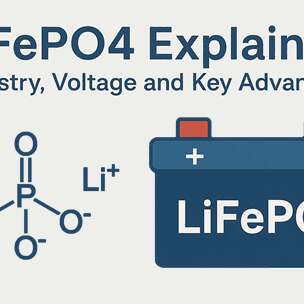How to Choose the Right LiFePO4 Battery: Sizes 50Ah to +300Ah (12V 100Ah, 12V 200Ah, 24V 100Ah, 48V)
Picking a LiFePO4 battery feels simple until you face inverter specs, solar charge controllers and real world runtime. This short guide slices through the jargon so you actually get the right pack for RVs, tiny homes, boats, or solar backup. #LiFePO4 #SolarBattery #12V100Ah
Start with the math (fast and practical)
Estimate daily energy need in watt/hours. Convert to amp/hours by dividing by system voltage, then divide by usable depth of discharge. Example for a 12V system powering 1,200 Wh per day:
1,200 Wh ÷ 12 V = 100 Ah- If you use 80% usable capacity,
100 Ah ÷ 0.8 = 125 Ahneeded, so choose a12V 150Ahor12V 200AhLiFePO4 for headroom.
Common sizes and typical uses
LiFePO4 50Ah, small portable power stations, scooters, shallow RV ancillary loads.LiFePO4 100Ah (12V 100Ah), the workhorse: weekend RVing, off- grid cabin basics, medium UPS.LiFePO4 200Ah (12V 200Ah / 24V 100Ah), multi day autonomy for cabins, larger inverter loads, serious solar battery banks.+300Ah (12V 300Ah / 24V 200Ah / 48V options), whole house backup, heavy marine systems, long run solar storage.
Voltage choice matters
Lower voltage systems like 12V LiFePO4 battery are simpler and cheap, but higher voltages (24V, 48V) reduce current, allow thinner cables and smaller inverters for the same power. For power above 2,000 W, lean toward 24V or 48V.
Key technical points that actually change performance
- BMS LiFePO4: non negotiable. A Battery Management System protects against cell imbalance, overcharge, and overdischarge. Look for built in BMS with cell balancing and safe current limits.
- Charge voltage guidance: LiFePO4 cells typically charge to about
3.60-3.65 Vper cell. That equates to roughly14.4-14.6 Vfor a 4s (12.8V nominal) pack,28.8-29.2 Vfor 8s (24V), and57.6-58.4 Vfor 16s (48V). Confirm with the manufacturer. - Cycle life and depth of discharge: Expect thousands of cycles at 80% DoD, far outlasting lead acid.
Practical selection tips
- If you need portability and occasional use,
50Ah-100Ahis fine. - For daily heavy loads or solar self consumption, start at
200Ahand scale up. - For inverters over 3 kW pick 24V or 48V battery banks.
- Match charger and inverter to LiFePO4 charging profile and BMS limits; not all lead-acid chargers suit LiFePO4.
- Choose capacity for real energy need and Add 20 to 30 percent for reserve.

